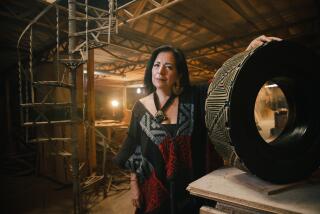Xavier Montes, maestro of Latino culture in Ventura County, dies at 67
- Share via
In 2004, Anna Bermudez received some unsolicited advice from Xavier Montes about one of her art pieces.
Tall, mustachioed and almost always dressed in white slacks, a white guayabera and a Panama hat, “Big X” cut an imposing path throughout Ventura County’s Latino community.
He was the founder of the De Colores Art Show, an annual showcase of music, dance and art held in his hometown of Santa Paula. The swirling arpeggios Montes plucked out of his harp provided soundtracks to fundraisers and community nights from Ojai to Oxnard; his paintings, usually ruminations on Mexican themes or farmworkers, hung in the home of the region’s Latino intelligentsia.
Montes sought out Bermudez after her politically themed rebozo (Mexican-style shawl) on display at the Museum of Ventura County impressed him.
“He said, ‘You know what? You gotta keep doing this,” said Bermudez, who’s now the museum’s chief curator. “He did this with everyone. He always talked you up. Talking to him gave you impetus to do more.”
Fourteen years after their initial encounter, Montes asked Bermudez for a favor: Montes was ready to step down from De Colores, and wanted the museum to take over his festival. It will relaunch next year.
“It’s like the passing of the torch,” Bermudez said. “Something he did for so long, and now it’s up to all of us to continue it. He knew we were ready.”
Following a long illness, Montes died Thursday at age 67.
“He was just a magnet for people,” said Jennifer Heighton, executive director of the Santa Paula Art Museum, where Montes was a board member for years and helped to start a collection devoted to Chicano art. “People wanted to be around him and to learn from him. He loved his community. He was completely committed to it.”
“He was a tlamatini,” said Javier Gomez, artistic director for Oxnard’s Inlachek Cultural Arts Center, using a Nahuatl term that roughly translates as “wise man.” Montes was a student-teacher for him in 1973 in Camarillo, and the two collaborated on projects for decades. “He showed us how to feel our hearts, see our faces, and express our soul.”
Montes initially didn’t plan to help nurture Chicano arts in Ventura County. Born in 1952 to farmworkers, Montes was raised by an aunt as her own son. She gave her ward the inside-out covers of old books as drawing material because she didn’t have money for art supplies.
After stints at Moorpark and Ventura colleges, he earned a bachelor’s degree in studio art and a teaching credential from UC Santa Barbara, staying in the area after graduation. Montes’ mastery of acrylics notched him exhibits in Los Angeles and San Francisco, among other big cities.
But he returned to Santa Paula in 1983 to take care of his ailing tía. While the tug of the bigger world out there piqued Montes, he decided to bring the world to his sleepy agricultural town instead.
“I wanted to be part of this movement, but I wasn’t a public speaker, or a real radical protester,” he told the Ventura County Star in 2015. “This was one way of participating and promoting my culture: through music.”
By then, Montes already owned a harp, an instrument he fell in love with after listening to an album of son jarocho music at UC Santa Barbara, and had become a prolific guitar player. He released two albums of instrumentals that swung from Mexican standards like “Veracruz” and “Amor Eterno” to Greatest Generation classics like “White Cliffs of Dover” and “Guantanamera.”
He also recorded “La Inundacion,” a corrido about the 1928 collapse of the St. Francis Dam that leveled Santa Paula and killed at least 431 people in what remains the second-largest loss of life in California history after the 1906 San Francisco earthquake. He helped paint murals, offered free guitar workshops to seniors at churches or at his house, and created a children’s group, Angels on Harps.
All of this culminated every year with the De Colores Art Show, which started in 1994 as a street bazaar but eventually transformed into a weeks-long affair that drew artists and attendees from across Southern California.
“Cultural arts moves my inner spirit, it instills an energy in me that words cannot express,” he said in a 2004 speech. “It is this love and this excitement that moves me to want so desperately to share with all of you so that you, too, can feel what I feel.”
In 2005 and 2007, Montes gathered dozens of elderly musicians who had helped to make Santa Paula a hotbed of Mexican music before World War II to document their life stories. In his later years, Montes also worked at Santa Paula’s Blanchard Community Library and Renaissance High School while continuing to produce art and music for himself.
“He was a big role model the way he lived his life,” said Juan F. Ramirez, a Visalia resident who was Montes’ roommate in college. He remembered how, on weekends back home, Montes played corridos late into the night at Las Piedras Park to friends and strangers alike. “He always gave of himself. He never cared about himself.”
Montes is survived by his partner, Vanessa Acosta, two sisters and two brothers, daughter Anica Walls, son Robert Montes, and two grandchildren.
More to Read
Start your day right
Sign up for Essential California for the L.A. Times biggest news, features and recommendations in your inbox six days a week.
You may occasionally receive promotional content from the Los Angeles Times.







